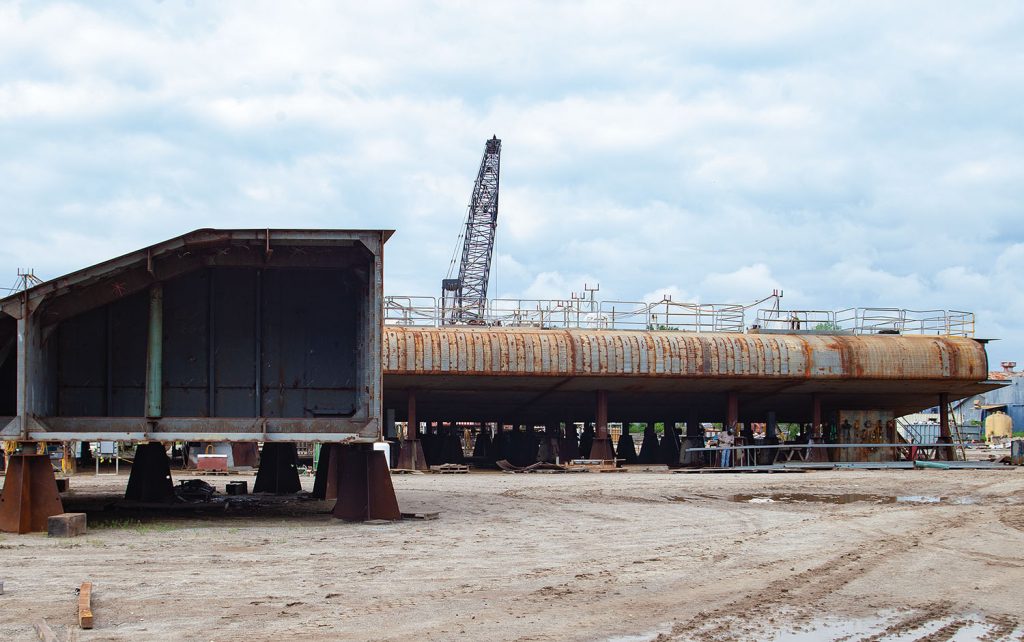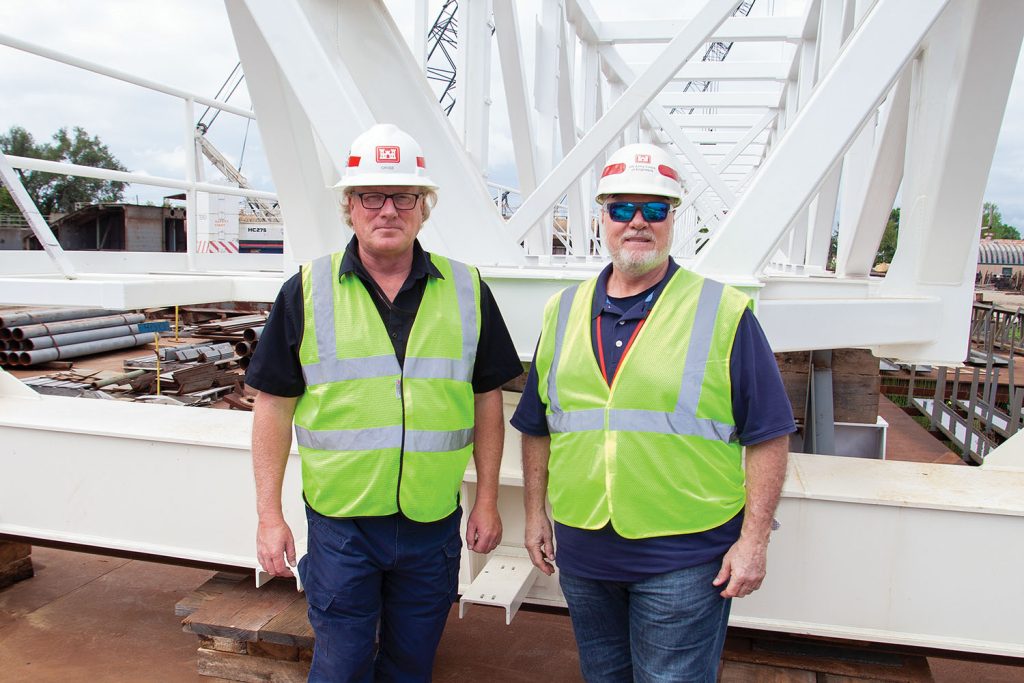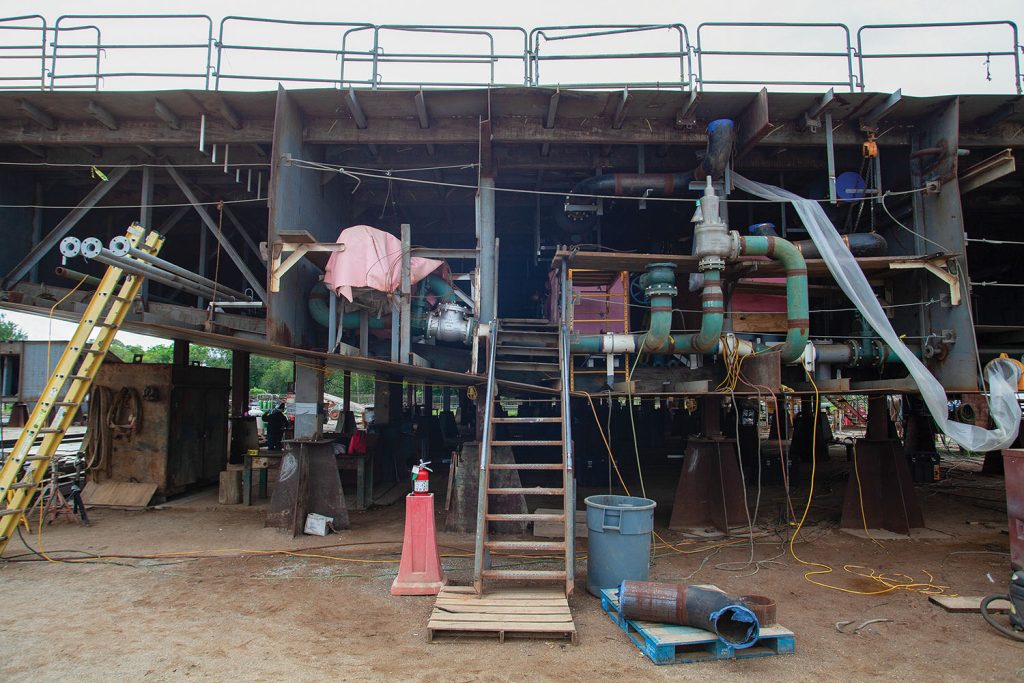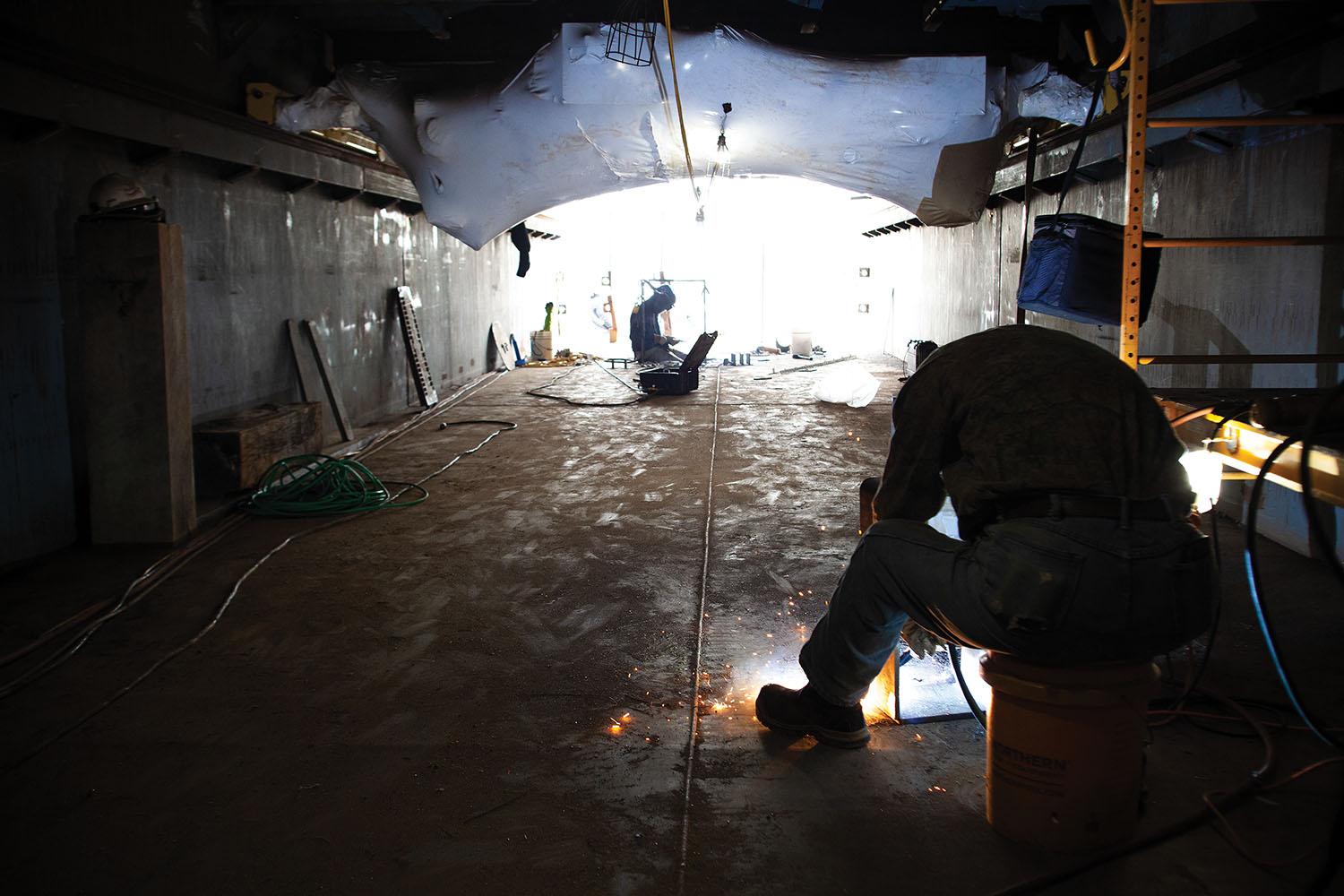The Vicksburg Engineer District’s Mat Sinking Unit (MSU), rarely ever even seen by the public but nonetheless hard at work each low-water season, is an indispensable part of the Corps’ flood control and navigation mission on the Lower Mississippi River. For about 75 years, the current unit, based in Vicksburg, Miss., and its crew of close to 300 have been armoring the river—lining the river bottom from the bank toward the channel—with articulated concrete mattress, or “mat.” Doing so stabilizes the river bottom and helps prevent further scouring at problem spots.
But the current unit, venerable though it may be, is incredibly vulnerable to unplanned and costly maintenance issues. Gantry cranes; broken-down pneumatic tie tools, jackhammer-like tools that stitch concrete “squares” together to form the mats; mechanical mooring winches; wiring harnesses—virtually all components of the current unit are prone to failure and expensive to fix. On average, the Corps spends between $9 million and $10 million per year on mandatory repairs just to keep the Mat Sinking Unit up and running.

Those days, though, are coming to an end, with the Corps’ new $125 million MSU, dubbed ARMOR 1, nearing completion at Thoma-Sea Marine Constructors’ shipyard in Lockport, La. ARMOR 1, which will revolutionize the matlaying mission, is due out sometime between December this year and February 2024, with sea trials to follow that.
“Then we’ll ship it up to Vicksburg and use it during the 2024 season,” said John Cross, project manager of ARMOR 1 and former commander of the Vicksburg District.
It’s hard to understate how big an upgrade the new unit will be. Cross said, when the Corps team approached the MSU replacement project, it adopted three main tenets or points of emphasis for ARMOR 1: safety, efficiency and reliability.
In terms of safety, ARMOR 1 will meet all applicable safety regulations from the American Bureau of Shipping (ABS), the Corps and the Occupational Safety and Health Administration (OSHA).
“The current unit doesn’t meet current regulations because it was built in 1948,” Cross said.
Regarding efficiency operations, Cross said the current MSU averages 1,300 to 2,000 concrete squares per day, with a “square” measuring 4 feet by 25 feet.
“We wanted this thing to operate much more efficiently,” Cross said of ARMOR 1. “We went into this saying we want to double it to 4,000 per day.”
That ability will not only mean ARMOR 1 will be able to address more or all of the problem spots the Corps identifies along the Lower Mississippi and surrounding rivers (occasionally the MSU ventures into the Atchafalaya River), but it will also benefit the marine industry, with fewer and shorter closures on the river.
“It’s like fixing a highway three times faster,” Cross said.

Reliability will be a big upgrade as well, with the new MSU employing cutting-edge robotics and automation. The Vicksburg District partnered with the Corps Marine Design center, SIA Solutions LLC, Bristol Harbor Group Inc. and the National Robotics & Engineering Center (NREC) at Carnegie Mellon University on the design. NREC designed the six new robotic cranes, which will move the squares from the mat barge to the deck of ARMOR 1, and the tying gantry, which will stitch the mats together. As squares are stitched together on the launch deck, winches will pay out cable, with the concrete mat sliding over the side to the river bottom.
The new MSU will be 74 feet wide, the same as the outgoing unit. However, ARMOR 1 will be 212 feet long, up from 180 feet. That added length gives ARMOR 1 more deck space and more buoyancy and allows for larger gantries. The new unit will also have a tow head for improved mobility.
“We tried to improve every single aspect,” Cross said. “For everything we’re doing, we wanted it to be better than what we have.”
The winches will all “talk” to each other, fine-tuning positioning or automatically shutting down operations before there’s an issue.
“All winches come standard with that now,” Cross said. “We just didn’t have it on the old one.”
Light Detection and Ranging, or LiDAR, will be built into ARMOR 1 so that operators will know exactly how the mat is settling down on the river bottom.
The long-term plan is to replace and upgrade the mooring barge as well, Cross said. But for the time being, ARMOR 1 will work alongside the unit’s current mooring barge. As the MSU lays the mat, this vessel moves laterally along the mooring barge, from the bank out into the channel.
Like the function and design of the new MSU, crew needs will also be much different aboard ARMOR 1. Overall, the crew count aboard ARMOR 1 will drop from about 278 to around 172. Much of that reduction will be in the mat-laying deck crew, which will go from about 100 to 28. The deck crew has historically been made up of temporary employees. Cross said moving forward that will no longer be the case.
“All of these jobs are moving to permanent,” Cross said. “We want to professionalize the workforce, so they will become professional employees of the Corps, which I think is good news.”
The Corps has partnered with Hinds Community College in Vicksburg, which has a new robotics program, to give crew members a first jump into the world of robotics. The Corps has also taken current MSU crane operators up to NREC in Pittsburgh to operate and critique the new equipment.
“Our guys are picking it up like that,” Cross said, snapping his fingers. “There is a lot of enthusiasm. They want a winner. They want to work on the marquee project.”
Cross said the new system will use artificial intelligence and machine learning to fine-tune placement of squares and stitch together the mats. A deck crew of 10, instead of lugging 60-pound tie tools all day, will follow behind the robotics equipment, doing quality control and making the few ties the system is unable to make. The new tie tools will be battery powered, rather than pneumatic, and will weigh 45 pounds. The new tie tools will be able to make about 100 ties per charge, and they will use common, light-weight rechargeable batteries, like those in lawn care equipment.
Construction Progress
From a funding and supply chain perspective, the ARMOR 1 project has avoided a lot of the funding shortages and materials issues plaguing other projects of late. Steel for the project, for example, was purchased and acquired in 2017 and 2018, so ARMOR 1 dodged the steep rise in steel prices seen over the past couple of years.
“We’ve really been fortunate,” Cross said. “Some of these things that usually take a year to get in, like winches, would take two years now. But we’ve got everything in to finish the job.”

Weather and workforce delays have been a different story. Like in every industry, the COVID-19 pandemic caused labor issues at the shipyard. Then came Hurricane Ida in late August 2021. The hurricane knocked out power to the shipyard for four to six weeks and damaged much of the housing in the region. Ultimately, the shipyard had to rebuild much of its workforce due to displacement from Hurricane Ida and an overall shortage of available skilled workers.
Those challenges pushed the delivery and deployment of ARMOR 1 back a year.
Much of the hull for ARMOR 1 is already assembled, with on-deck modules and equipment soon to be stacked. Cross said he expects the vessel to be launched later this summer.
ARMOR 1 is a revolutionary project, much like the old MSU was when it came out in 1948, and the Corps is up to the task, Cross said.
“We built the Panama Canal,” he said. “We built the NASA facilities. We can build a better machine.”




